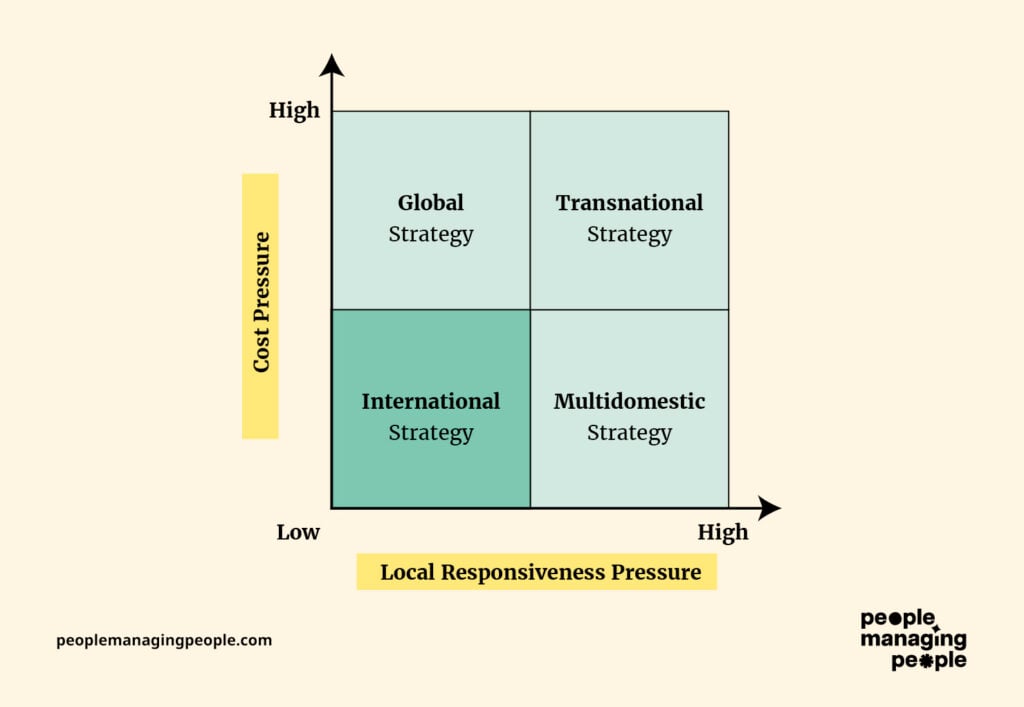There comes a time in many an organization’s development when they start looking beyond their home country to take advantage of opportunities in international markets.
If this is you, then you’ve come to the right article. Use this article as a starting point to help you launch your international strategy.
What Is An International Strategy?
An international strategy is a plan or approach that a company adopts to conduct its business operations outside its home country.
It covers the ways an organization markets and manages its products, services, and operations across different countries.
There’s no one-size-fits-all approach here, with various models of expansion to choose from:
International strategy (home replication)
This strategy focuses on exporting products and services to foreign markets, leveraging domestic capabilities. Companies typically maintain headquarters in their home country, avoiding significant investments in overseas staff or facilities.
While this approach offers centralized control and streamlined operations, it may face challenges such as managing global logistics and complying with foreign regulations.
Multi-domestic strategy
In a multi-domestic strategy, companies tailor their products or services to meet the specific needs and preferences of each local market. Operations are decentralized, granting local subsidiaries the autonomy to make decisions.
This enhances local responsiveness but can lead to higher operational costs and complexities in managing diverse operations.
Global strategy
A global strategy involves standardizing products and services across all markets to achieve economies of scale. Companies centralize operations and focus on efficiency and consistency. While this approach reduces costs, it may not adequately address local market nuances and preferences.
Transnational Strategy
This strategy seeks to balance global efficiency with local responsiveness. Companies integrate operations worldwide while allowing local branches the flexibility to adapt offerings.
Although complex and resource-intensive, this approach enables firms to compete effectively in diverse international markets.
How An International (Home Replication) Strategy Differs
Any international business strategy strikes a balance between two key factors:
- Global integration: How centralized and unified a company’s operations are across markets.
- Local responsiveness: How much a company adapts its products or services to local needs.

As you can see from the above graph, international strategy sits in the low cost, low responsiveness quadrant.
Organizations develop products/services in the home country and simply sells them abroad with little to no change.
The focus is on leveraging domestic success globally without much adaptation.
It’s a popular tactic for organizations at the early stages of global expansion, where the domestic market is still very much the focus.
As international operations take off, they’ll likely switch to another strategy type.
International Strategy Example: Nike
In Nike’s earlier international expansion phases, it sold its U.S.-designed footwear and sportswear in foreign markets without much alteration.
The company controlled product development and branding centrally, assuming the U.S. model would resonate globally.
Over time, as Nike scaled, it incorporated more localized marketing, partnerships, and even region-specific products—shifting closer to a transnational strategy.
7 Benefits Of An International Strategy
An international strategy (aka home replication strategy) can be a smart starting point for companies going global. It’s all about leveraging what already works at home—and doing it efficiently.
1. Low risk market entry
You’re not building foreign operations from scratch—you’re simply exporting your existing products or services. It’s a great way to “test the waters” in new markets with minimal commitment.
2. Cost efficiency
Centralized production and decision-making mean lower costs. You avoid the expense of setting up local subsidiaries, hiring in-country teams, or retooling your products for each region.
3. Brand consistency
You maintain a strong, unified brand image across all markets. This helps with global brand recognition and simplifies marketing and messaging.
4. Operational simplicity
Processes, supply chains, and management stay streamlined. You’re not dealing with the complexity of adapting operations for every country—you’re running a single playbook.
5. Leverages existing strengths
The strategy maximizes what you already do well—successful products, proven marketing strategies, efficient operations—so you’re not reinventing the wheel for each new market.
6. Economies of scale
Producing at scale in one place, then distributing globally, helps you reduce per-unit costs. This is especially beneficial in manufacturing, tech, or consumer goods.
7. Faster time to market
Since you’re using products that already exist, you can enter new markets more quickly—without waiting for R&D, redesigns, or market-specific testing.
How To Create An International Strategy
An international strategy—especially a home replication model—focuses on leveraging your existing products, services, and operational strengths in new markets with minimal change.
Below are the key steps to help you plan, launch, and scale your international presence effectively while keeping costs and complexity under control.
1. Define your goals
Ask yourself: Why go international? Common goals include:
- Reaching new customers
- Diversifying revenue
- Leveraging excess production capacity
- Establishing a global brand.
Tip: Be clear on what success looks like—revenue targets, market share, or brand recognition.
2. Identify suitable markets
Do market research to find countries where your existing product or service can succeed without major changes. Consider:
- Cultural similarities
- Language compatibility
- Economic and political stability
- Demand for your offering
- Ease of doing business
Tip: Tools like the World Bank’s Doing Business Index or trade data can help here.
3. Assess readiness
Is your company operationally ready to handle international orders, support, and logistics?
- Can you ship products efficiently?
- Is your customer service set up to handle multiple time zones or languages?
- Are your legal, financial, and tax systems prepped for cross-border sales?
Start with a manageable region (e.g., Canada or the UK for U.S. companies) to ease into the process.
4. Choose your entry mode
Since this is a home replication strategy, your main entry methods might include:
- Exporting (direct or through distributors)
- Licensing or franchising
- Selling through international e-commerce
- Using agents or partners
5. Centralize core functions
Maintain product development, branding, and decision-making in your home country. This keeps things efficient and aligned. However, be ready to tweak operational processes slightly to meet import/export rules or service expectations.
Tiip: Think of this as running your business globally from headquarters—not building a bunch of new mini-branches.
6. Build supporting capabilities
- Add multilingual support or at least localized FAQs.
- Make sure your website and ordering process are usable by international customers.
- Prepare your supply chain for international shipping, customs, and returns.
7. Monitor, learn, and adapt
Track performance in each market:
- Sales volume
- Customer satisfaction
- Operational issues.
Tip: Use what you learn to refine your strategy—or pivot to a more localized approach if the market demands it.
Bonus: Don’t forget the legal side
- Understand tariffs (hot topic currently), taxes, and customs duties
- Register trademarks internationally if needed
- Know data protection laws (like GDPR)
Top 5 International Strategy Examples
Many global companies have successfully used an international strategy to scale their operations and test new markets with minimal adaptation.
Below are five standout examples of how businesses leveraged home-grown products and centralized operations to grow internationally.
Microsoft—exporting software worldwide
Microsoft has long followed an international strategy by developing its core software products (like Windows and Office) in the U.S. and distributing them globally with minimal changes.
While they localize languages, the core functionality and design are the same everywhere. This strategy allows for centralized product development and global scalability.
2. Harley-Davidson—selling the american lifestyle
Harley-Davidson exports its iconic motorcycles to international markets without significantly changing the product or brand.
It leans into its "Made in America" identity, appealing to consumers abroad who want a piece of U.S. culture. The brand’s consistency and heritage make this approach work across borders.
3. Netflix (early international expansion) – same platform, same content
When Netflix first expanded into markets like Canada, the UK, and parts of Europe, it exported its U.S. content library with minimal localization.
The platform, user experience, and recommendations were nearly identical to the U.S. version.
This helped Netflix scale quickly while learning how different audiences responded to its existing content.
4. Tesla – centralized product, global demand
Tesla designs and manufactures most of its cars and tech in the U.S., then exports them to international markets with very little product adaptation.
The appeal of the Tesla brand and its innovation means the same cars can sell in China, Germany, or Australia without needing major modifications. Operations remain highly centralized.
5. IKEA (early days) – flat-pack swedish design, exported globally
In its earlier years, IKEA exported its Scandinavian-style furniture and showroom concept to other countries without much localization.
The company replicated its warehouse-style stores and product lines abroad, banking on the appeal of affordability and minimalist design.
While IKEA later evolved its model, this replication approach helped it gain global traction quickly.
International Strategy: A Quick Route To International Expansion
Organizations often choose an international strategy as their first step into global markets because it allows them to leverage existing products, processes, and brand identity without the complexity of full localization.
This approach minimizes risk and cost by keeping operations centralized and exporting offerings that have already proven successful in the home market.
It’s especially useful for testing international demand, building early brand recognition, and achieving quick scalability.
While effective in the short term, companies may later adapt or evolve their strategy as they learn more about local consumer preferences, regulations, and competitive landscapes.
Subscribe To The People Managing People Newsletter
For more advice on international strategies and hiring globally—subscribe to our weekly newsletter for HR and business leaders. You’ll receive all our latest content to help you grow in your career and make greater impact in your org.



